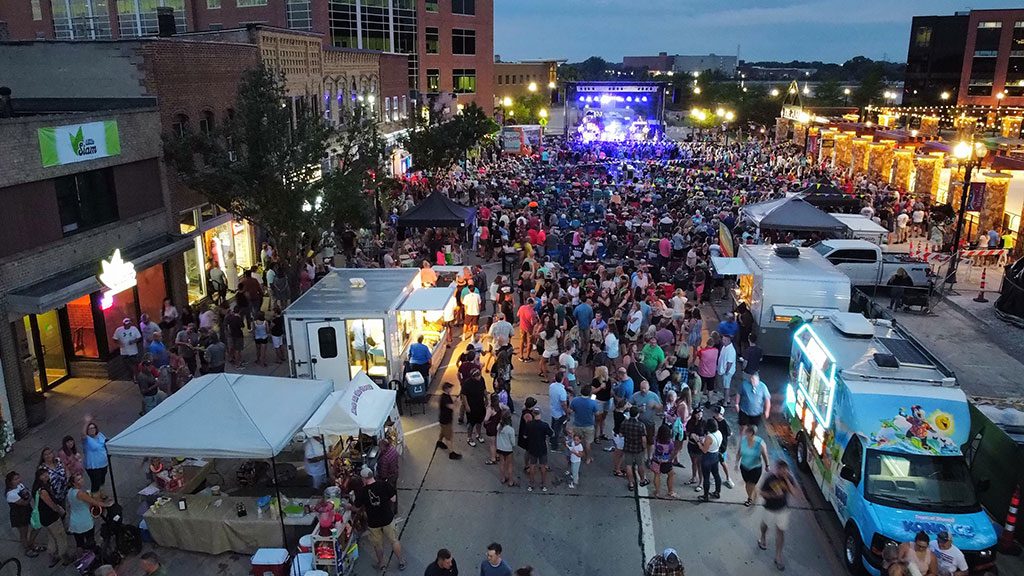
Entertainment districts, also known as Outdoor Refreshment Areas or Open Container Districts, have existed in many states for decades but are relatively new in Wisconsin.
In many cases, a pivot to outdoor dining during the COVID-19 pandemic led to a need to think more broadly about the ordinances governing drinking and dining outdoors. To date, at least eight Wisconsin municipalities have created ordinances that allow open intoxicants in designated public spaces downtown, under specific circumstances. These ordinances vary greatly. Some use expanded picnic licensing parameters to allow events that incorporate alcohol to take place in the public right-of-way while others designate certain days or times when people can carry open intoxicants on the streets or sidewalks within a designated area. A recent webinar profiled several of these districts, explaining how they were established, outlining the economic benefits they have generated for their districts, and offering tips for other communities considering implementing similar measures.
Here are some examples of entertainment districts established in Wisconsin:
Event districts
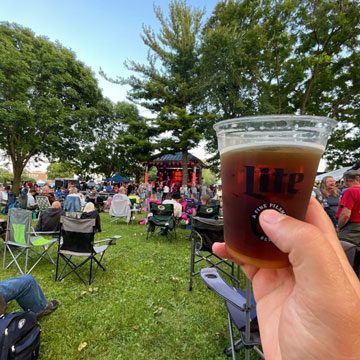
Ripon’s Village Green is home to a summer concert series which is now able to take advantage of an event district permit to allow downtown businesses to participate.
Many communities have adapted their picnic ordinances to allow sections of the downtown to be considered an event location, similar to regulations governing alcohol use in parks for many communities. These event-specific districts tend to be smaller, encompassing only a few blocks within the core of a district, and therefore, are easier to monitor. The event host is responsible for checking IDs and communicating district rules to businesses—for instance, in a wine walk–or to servers, if there is a beverage tent. Depending on the community, security staff or volunteers may be stationed at the edges of the district to ensure that participants remain inside the designated area.
Events such as a wine or beer walk that are held within a district can incorporate downtown public rights-of-way into the event, minimizing crowding at individual businesses. Having a designated district also helps bars and restaurants get involved in an event by offering a to-go menu to cater to those who attend. Ripon’s Open Container Event permit has allowed more people to participate in wine and beer walks. It has also helped downtown restaurants and bars attract traffic from the popular Ripon Summer Concert Series, which had restricted alcohol purchases in the past to the concert site at Ripon’s Village Green.
General districts

Oshkosh’s Downtown Outdoor Refreshment Area is enjoyed by a wide variety of visitor groups.
In contrast to event-specific districts, general districts allow public consumption of alcoholic beverages within a designated geographic area, some or all of the time. In such districts, servers at licensed establishments are responsible for checking IDs and providing appropriate to-go containers for customers leaving the premises.
In Sturgeon Bay, the all-hours Walking Area Entertainment District was created to allow for social distancing during the pandemic. The public enjoyed the concept so much that it has since been renewed and has sparked new events, such as the Under the Stars Night Market. In addition, patrons waiting for tables at restaurants in the district can explore the downtown area, stroll a popular bridge walking path, or walk in public parks within the district, with a beverage in hand.
Oshkosh and Neenah both promote Downtown Outdoor Refreshment Areas, and Stevens Point has an Open Container Ordinance covering a designated area downtown. Each community has designated specific hours during which open carry is allowed. Stevens Point and Oshkosh initiated their entertainment districts during the pandemic, while Neenah’s ordinance is new this year. All three communities say the designation has brought positive results. District businesses have seen increased sales from customers purchasing beverages during events to accompany takeout food from nearby restaurants or just to sip while strolling through downtown. Events have benefitted as well, with increased attendance and longer stays; some events have launched while others have moved downtown to take advantage of the district.
Creating & Managing Districts
-
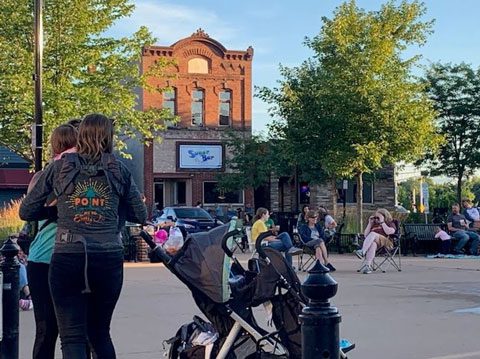
Stevens Point’s Notes@Night program draws families downtown for vendors and music, and now patrons can enjoy takeout beverages and meals, as well.
Understand state law. Wisconsin laws are different from those in other states with long-running entertainment district programs. Ensuring that your proposed program complies with state laws—or more stringent local ordinances—is important. For instance, districts that are created around events require an eligible nonprofit organization to apply for the picnic license. Regardless of the type of district, beverages purchased in one establishment cannot be taken into another business.
Some useful references: -
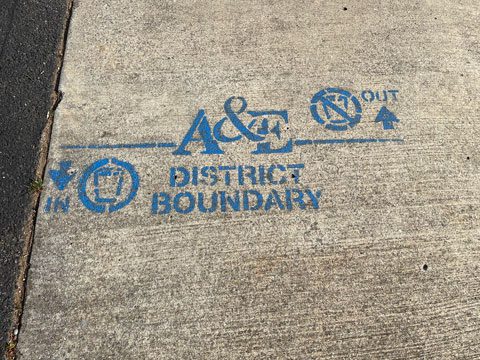
This sidewalk stamp, located at each edge of the district, provides a visual reminder that you are leaving the district.
Establish clearly defined district boundaries. Ideally, the district boundaries correspond to a broadly conceived notion of downtown and include most of the parks, public spaces or businesses that would wish to be included in district events. Once the boundaries are established, make sure that all businesses know where they are. Install ample signage, whether through street signs, sidewalk stencils, event posters, or on physical barricades (in the case of event-only districts).
-
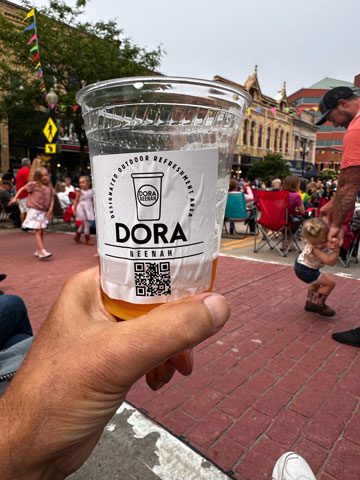
Unbreakable containers that are clearly marked are commonly required. These cups in Neenah also include a QR code that links to a full copy of district rules and regulations.
Define the rules. Regardless of the type of district being created, a set of ground rules is needed to ensure that everyone is complying with both local rules and state alcohol beverage laws. Rules designate which entity is responsible for checking IDs; typically, it is the business or vendor selling alcoholic beverages, and sometimes hand stamps, wristbands, or other visible identification is required. The rules also require that insurance coverage is adequate for the volume of visitors and the type of event, and they clearly define the types of beverages and containers that can be used in the area.
Some communities already allow open intoxicants in parks, and many of them employ the same rules in entertainment districts, such as unbreakable containers, and either original packaging, clear cups, or branded cups. This prevents people from entering the district with their own beverages of unknown origin. Depending on the makeup of the entertainment district, its businesses, and its visitors, additional regulations such as removing parking lots or establishing policies for businesses that do not comply with the rules can increase the chances for success.
-
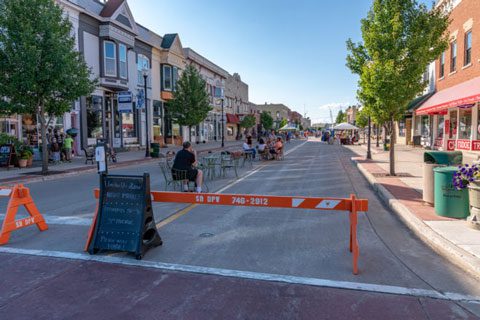
Sturgeon Bay’s open container district launched with an expanded outdoor dining area, but has evolved to allow patrons to walk around downtown with a beverage while waiting for a table during busy dining times or on warm summer evenings. Photo Credit: Brett Kosmider
Be sure your district is ready. While none of the districts interviewed noticed an increase in troubling behaviors as a result of having an outdoor beverage area, it is important to recognize that having such a district may change the way people interact with each other and experience the district. Simple things like placing an adequate number of trash cans near gathering spaces and near district exits can go a long way toward encouraging good behavior. It may also be helpful to add seating, lighting, or other amenities that will make visitors more comfortable experiencing the district in a new way.
- Education is the key to success. Teach district businesses about the rules and regulations—and how they can benefit—and inform the general public in order to set expectations, ensure compliance, and offer more ways for people to enjoy your community’s downtown.
